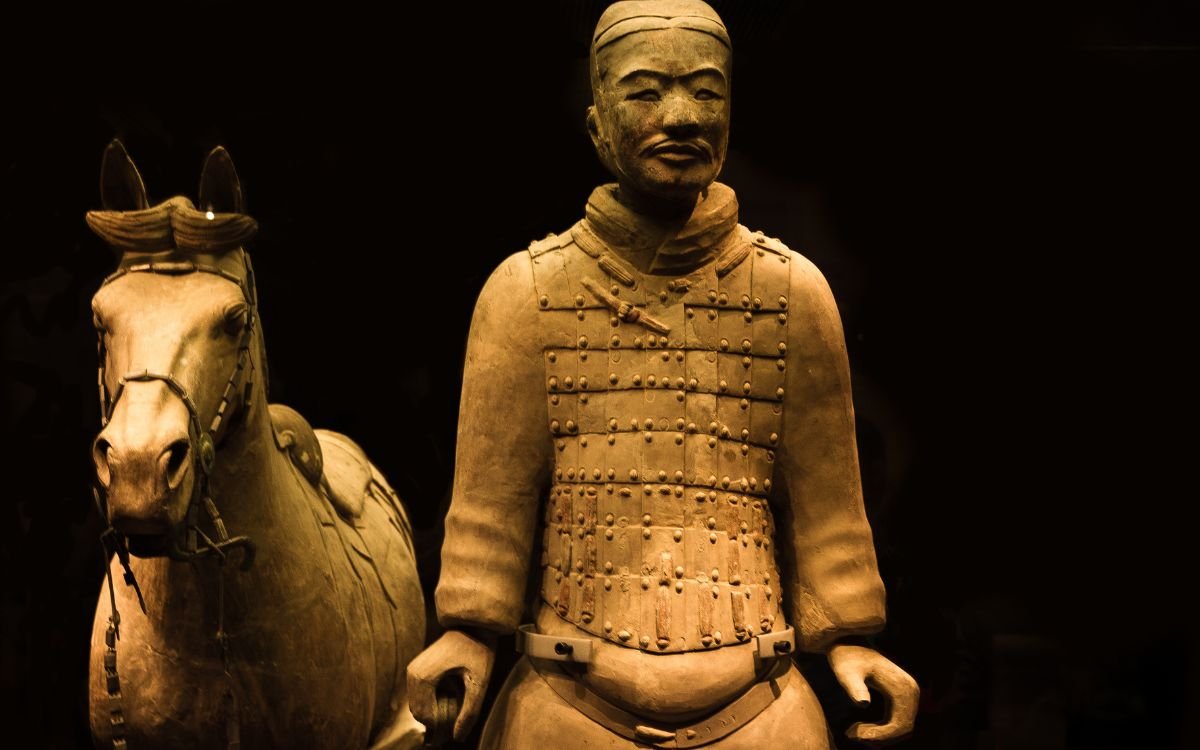Introduction to the Terracotta Warriors
Imagine stumbling upon an ancient army, meticulously crafted from clay and standing guard in a hidden tomb for over two millennia. This is the awe-inspiring reality of the Terracotta Warriors, one of history’s most remarkable archaeological discoveries. Found in Xi’an, China, these life-sized statues are more than just relics; they represent a fascinating chapter in Chinese history. With thousands of warriors poised to protect their emperor even in death, the Terracotta Army captures our imagination as it reveals insights into ancient Chinese culture and artistry. Join us on this journey as we delve into the rich tapestry surrounding these iconic figures and uncover the stories that make them legendary.
History and Discovery of the Terracotta Army
The Terracotta Army was discovered in 1974 by local farmers digging a well near the ancient capital of Xi’an. They stumbled upon something extraordinary—thousands of life-sized sculptures buried underground.
This remarkable find dates back to around 210-209 BC, during the reign of China’s first emperor, Qin Shi Huang. The army was crafted to accompany him in the afterlife, showcasing his power even beyond death.
As archaeologists began excavating the site, they unveiled an astonishing collection: soldiers, horses, and chariots meticulously arranged in battle formation. Each piece varied in size and facial features, reflecting individuality among them.
Over time, more than 8,000 figures have been unearthed along with numerous weapons like swords and spears. This monumental discovery not only shed light on ancient Chinese culture but also revealed advanced techniques in craftsmanship from that era.
Significance and Purpose of the Warriors
The Terracotta Warriors serve as a powerful testament to the beliefs of ancient China. They were created during the reign of Emperor Qin Shi Huang, who sought immortality and protection in the afterlife.
Each warrior symbolizes strength and loyalty, reflecting the values that defined Chinese society at that time. Their presence was meant to guard him against any threats beyond death.
As part of a grand burial complex, these figures also showcase the emperor’s immense power and resources. This army was not just about military might; it represented his desire for eternal dominance.
Moreover, this monumental project highlighted advanced craftsmanship in ancient China. The warriors were intricately designed and varied in height, rank, and attire—signifying their roles within an actual army.
Their significance extends beyond historical context; they embody cultural identity and continuity for modern China. These statues are much more than clay figures—they’re a bridge connecting past traditions with contemporary appreciation.
Uniqueness and Detail of the Sculptures
The terracotta warriors stand out not only for their quantity but also for their incredible detail. Each figure is an individual masterpiece, showcasing a variety of facial expressions and hairstyles.
Crafted during the Qin Dynasty, these sculptures reflect the artistry and craftsmanship of ancient China. The level of realism is astonishing; you can see intricate armor designs that were once vibrant with color.
No two soldiers are alike. From generals to archers, each warrior has unique features that hint at their rank and role within the army. This attention to detail extends even to their clothing and accessories.
Some figures display life-size horses alongside them, adding another layer of depth to this remarkable burial complex. The artisans poured heart and soul into every piece, creating a narrative frozen in time amid clay and earth.
Preservation and Conservation Efforts
Preserving the Terracotta Warriors is a monumental task. These ancient sculptures face threats from environmental conditions and human interaction.
Conservation teams work tirelessly to maintain their integrity. They employ advanced techniques, including climate control and humidity regulation, to protect these artifacts from deterioration.
Each warrior requires meticulous care. Experts analyze soil composition and test for chemical reactions that could cause damage over time.
Innovative restoration methods are constantly being developed to ensure that any wear or damage can be addressed without compromising the original craftsmanship.
Public awareness also plays a vital role in preservation efforts. Educating visitors about respectful viewing practices helps minimize risks associated with high foot traffic around the site.
The combination of science, artistry, and education fortifies the future of these incredible relics while allowing generations to appreciate their historical significance.
Impact on Modern Chinese Culture
The Terracotta Warriors have transcended their historical roots, becoming an emblem of cultural pride for modern China. These ancient figures inspire a renewed appreciation for Chinese heritage and craftsmanship.
In contemporary art and fashion, the warriors influence various creative expressions. Artists draw inspiration from their intricate details and stoic presence, resulting in vibrant reinterpretations that resonate with global audiences.
Tourism has also flourished around these remarkable sculptures. Millions flock to Xi’an each year, eager to witness this UNESCO World Heritage site. The influx of visitors stimulates local economies while fostering cross-cultural exchange.
Moreover, educational programs centered on the Terracotta Army promote awareness of China’s rich history among younger generations. This helps cultivate national identity and encourages curiosity about ancestral traditions.
Through media representation—from documentaries to films—the warriors continue to capture imaginations worldwide. They serve as a bridge between antiquity and today’s dynamic culture.
The Purpose and Significance of the Terracotta Warriors
The Terracotta Warriors served a profound purpose beyond mere decoration. They were created to accompany Qin Shi Huang, the first Emperor of China, in the afterlife. These figures were meant to protect him on his journey into eternity, reflecting the emperor’s desire for immortality.
Each warrior held significance that extended into social structure and military organization. Their ranks mirrored real-life soldiers, showcasing various roles from archers to cavalrymen. This attention to detail illustrated not just artistry but an understanding of ancient warfare.
Moreover, these sculptures symbolize China’s rich heritage and historical legacy. They embody the strength and power of one of history’s most influential dynasties. As guardians of an era long past, they continue to fascinate scholars and visitors alike with their stories whispered through time.
This remarkable assembly sheds light on beliefs surrounding death and the afterlife in ancient Chinese culture—an enduring testament to human creativity and ambition.
Construction and Design of the Terracotta Army
The construction of the Terracotta Army reflects remarkable ingenuity. Crafted during the reign of Emperor Qin Shi Huang, this vast underground army was designed to accompany him in the afterlife.
Each warrior was made from local clay and meticulously shaped by skilled artisans. The process involved hand-molding individual figures before firing them in kilns. This method allowed for intricate details that set each sculpture apart.
The soldiers were not uniform; they varied in height, attire, and facial features, representing a diverse military force. Chariots and horses completed the ensemble, enhancing its realism.
Strategically positioned within burial pits, these sculptures formed battalions ready for battle in another world. The entire site is an architectural marvel with a layout that mirrors ancient military formations.
This monumental design showcases both artistic talent and cultural beliefs about life after death among early Chinese civilizations.
Preservation and Restoration of the Terracotta Warriors
Preserving the Terracotta Warriors is a meticulous task. Each figure, crafted over 2,200 years ago, faces threats from environmental factors and human activities. Archaeologists and conservators work tirelessly to protect these cultural treasures.
Restoration efforts focus on stabilization rather than full reconstruction. This approach respects the original artistry while ensuring longevity. Specialized techniques are employed to stabilize colors and prevent further deterioration.
Humidity control plays a crucial role in preservation. The climate at the site can cause paint pigments to flake or fade. Advanced monitoring systems help maintain optimal conditions for these ancient sculptures.
Additionally, public awareness is vital. By educating visitors about proper viewing etiquette, conservation teams hope to minimize impact during tours of this historic site. Every effort counts in maintaining the integrity of these remarkable relics for future generations to appreciate and admire.
Conclusion: The Legacy of the Terracotta Warriors
The Terracotta Warriors stand as a testament to ancient Chinese artistry and the vast cultural heritage of China. Their discovery has not only sparked global fascination but also revealed insights into the beliefs, practices, and ambitions of an entire civilization.
This remarkable army continues to inspire countless visitors who flock to Xi’an each year. They marvel at the skill involved in crafting these life-sized figures that were designed to protect Emperor Qin Shi Huang in the afterlife. Each warrior tells a story, showcasing individuality through unique facial expressions and attire.
The legacy of the terracotta warriors extends far beyond their physical presence. They symbolize China’s rich history, resilience, and dedication to preserving its past amid modern advancements. As scholars continue to study their significance, new interpretations emerge about their purpose within ancient society.
Moreover, these sculptures have permeated popular culture—appearing in films, literature, and art—further solidifying their status as icons of historical wonder. The ongoing preservation efforts remind us that while time may weather stone and clay, the stories they hold will endure for generations.
As we reflect on what these magnificent creations represent today—cultural pride, artistic achievement, and historical inquiry—we realize that they are not just relics from an ancient era; they are bridges connecting us with our shared human experience across time and space.








